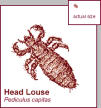 |
 |
 |
 |
SUBJECT: pediculosis capitis (head lice) is a very common parasite, especially in school-age children. These lice infestations are highly communicable. I want to emphasize that anyone can get lice; it has nothing to do with age, socioeconomic level, or cleanliness. The louse does not jump or fly, but it can be transmitted from one person to another on personal items. I strongly encourage children NOT to share combs, hair accessories, hats, caps, carves, coats and other items used on or near the hair. The adult louse lives only about 48 hours when NOT on a person, although, the life span average on a person is 28 days. Head lice go through 3 stages for a total of 40-50 days in their life cycle: egg stage, nymph stage (just hatched) and the adult stage after 12 days. The adults move very quickly and will hide from light. Their color often adapts to the hair color, which makes them difficult to see. Eggs are usually deposited at night, which will hatch in 7 to 10 days. The challenge is to treat the head lice before they reach the adult stage.
DETECTION: parents or guardians should carefully inspect the head of their child who scratches his/her head more than usual for bite marks, redness, and white nits (eggs). The most common sites are on the back of the head, behind the ears, and at the nape of the neck. Nits are firmly attached to the hair shafts and must be differentiated from dandruff, lint, hair spray, and other items of similar size and shape. Head lice cannot be spread from pets to humans or vice versa. Please notify the school nurse if any lice are found.
TREATMENT: consists of the application of pediculicides to dry hair for 10 minutes and manual removal of nits. Over the counter products are RID, Triple X, and lice killing shampoos for over 2 years of age and NIX for infants and under 2 years of age (Whaley and Wong, 1999). READ the directions carefully on the product used because some require two treatments. Machine wash all washable clothing, towels, and bed linens in hot water, and dry in a hot dryer for at least 20 minutes. Dry-clean non washable items. Thoroughly vacuum carpets, car seats, pillows, stuffed animals, rugs, mattresses and upholstered furniture. Seal non washable items in plastic bags for 14 days or put bags into the freezer, if unable to clean or vacuum. Soak combs, brushes, and hair accessories in a lice-killing product for 1 hour or in boiling water for 10 minutes. Again, please discourage sharing of personal items.
Disclaimer: This information is not intended be a substitute for professional medical advice. It is provided for educational purposes only. You assume full responsibility for how you choose to use this information.